The Prime Minister's home
In 1941 John Curtin became Australia's Prime Minister at a very testing time in the country's history. He lived then in the Lodge in Canberra, returning to Perth only for short periods of time, but even those return trips entailed some shuffling of space within the house.
During the war years telecommunications between Perth and the rest of Australia acquired a new significance and the PMG worked to provide two three-circuit telephone systems to give improved access to the eastern states.
In Perth the number of new telephone connections was small, and directly related to the war effort or to life-threatening situations.
John Curtin's house in Jarrad Street had only one telephone which stood in the hall and rang constantly when he was at home. As Prime Minister he had an office in the Commonwealth Bank building in Perth that presumably was better equipped.
|
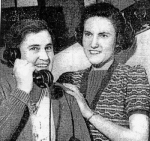
Mrs Curtin and Elsie hear the news that Labor has taken office

Curtin government after being sworn in to office, 1941 |
Despite his dislike of flying, John Curtin flew into Perth once during the war years. Flights were uncomfortable in those days as his secretary, Gladys Joyce recounts:

In his journeys between Perth and the eastern states, John Curtin usually took the train or coastal steamer. During the war he had no bodyguard and was probably the only wartime leader to stroll around the streets and railway stations with just one secretary. United States servicemen would marvel that he was alone.
|

The Prime Minister and party travelling in the Prince of Wales carriage across the Nullabor
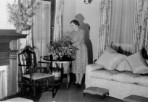
Mrs Curtin at the Lodge, Canberra, 1941
|
| Use of the house altered during the war years.
Son John joined the R.A.A.F., leaving his sleep-out empty for long periods.
In 1944 Annie Needham died, so the other sleep-out had no occupant.
Elsie Curtin spent at least two months of each year in Canberra with her husband and her daughter, who was working, kept the house running.
Government emphasis on frugality and austerity in order to wage the war effectively meant more than black-out curtains hung at every window.
A special feature in the Australian Women's Weekly of 19 September 1942 exhorted the reader to "Be a shock trooper in the Austerity Army!", inspiring the women of Australia to follow the lead given by Mrs John Curtin:

It meant food rationing and careful spending in order that government war bonds might be fully subscribed. The Curtin family had never been extravagant and no separate concessions were asked by them.
Curtin's personal secretary, Gladys Joyce, recounts the difficulties of obtaining postal stamps in war time, even for the prime minister!

|
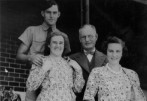
John and Elsie Curtin and family, 1942
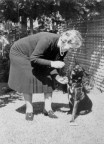
Mrs Elsie Curtin and "Kip", Cottesloe, 1942
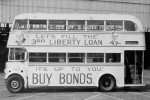
Double decker bus advertising Liberty Bonds, Sydney
|

